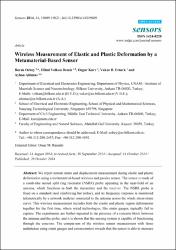| dc.contributor.author | Ozbey, Burak | |
| dc.contributor.author | Demir, Hilmi Volkan | |
| dc.contributor.author | Kurc, Ozgur | |
| dc.contributor.author | Erturk, Vakur B. | |
| dc.contributor.author | Altintas, Ayhan | |
| dc.date.accessioned | 2020-02-14T11:28:01Z | |
| dc.date.available | 2020-02-14T11:28:01Z | |
| dc.date.issued | 2014 | en_US |
| dc.identifier.issn | 1424-8220 | |
| dc.identifier.other | DOI: 10.3390/s141019609 | |
| dc.identifier.uri | https://hdl.handle.net/20.500.12573/164 | |
| dc.description | We gratefully acknowledge the support from The Scientific and Technological Research Council of Turkey (TUBITAK) EEEAG grant No. 112E255. We also thank Ramazan Ozcelik and Ozlem Temel for their valuable efforts in conducting of the experiments in Middle East Technical University. H. V. D. also gratefully acknowledges the support from European Science Foundation (EURYI), as well as TUBITAK BIDEB and the Turkish National Academy of Sciences (TUBA). | en_US |
| dc.description.abstract | We report remote strain and displacement measurement during elastic and plastic deformation using a metamaterial-based wireless and passive sensor. The sensor is made of a comb-like nested split ring resonator (NSRR) probe operating in the near-field of an antenna, which functions as both the transmitter and the receiver. The NSRR probe is fixed on a standard steel reinforcing bar (rebar), and its frequency response is monitored telemetrically by a network analyzer connected to the antenna across the whole stress-strain curve. This wireless measurement includes both the elastic and plastic region deformation together for the first time, where wired technologies, like strain gauges, typically fail to capture. The experiments are further repeated in the presence of a concrete block between the antenna and the probe, and it is shown that the sensing system is capable of functioning through the concrete. The comparison of the wireless sensor measurement with those undertaken using strain gauges and extensometers reveals that the sensor is able to measure both the average strain and the relative displacement on the rebar as a result of the applied force in a considerably accurate way. The performance of the sensor is tested for different types of misalignments that can possibly occur due to the acting force. These results indicate that the metamaterial-based sensor holds great promise for its accurate, robust and wireless measurement of the elastic and plastic deformation of a rebar, providing beneficial information for remote structural health monitoring and post-earthquake damage assessment. | en_US |
| dc.description.sponsorship | Turkiye Bilimsel ve Teknolojik Arastirma Kurumu (TUBITAK) 112E255 European Science Foundation (ESF) Turkiye Bilimsel ve Teknolojik Arastirma Kurumu (TUBITAK) Turkish Academy of Sciences | en_US |
| dc.language.iso | eng | en_US |
| dc.publisher | MDPI, ST ALBAN-ANLAGE 66, CH-4052 BASEL, SWITZERLAND | en_US |
| dc.relation.ispartofseries | Volume: 14 Issue: 10 Pages: 19609-19621; | |
| dc.rights | info:eu-repo/semantics/openAccess | en_US |
| dc.subject | displacement sensor | en_US |
| dc.subject | strain sensor | en_US |
| dc.subject | elastic-plastic region | en_US |
| dc.subject | metamaterial | en_US |
| dc.subject | structural health monitoring | en_US |
| dc.title | Wireless Measurement of Elastic and Plastic Deformation by a Metamaterial-Based Sensor | en_US |
| dc.type | article | en_US |
| dc.contributor.department | AGÜ, Mühendislik Fakültesi, Elektrik & Elektronik Mühendisliği Bölümü | en_US |
| dc.contributor.institutionauthor | | |
| dc.identifier.doi | 10.3390/s141019609 | |
| dc.relation.publicationcategory | Makale - Uluslararası Hakemli Dergi - Kurum Öğretim Elemanı | en_US |


















